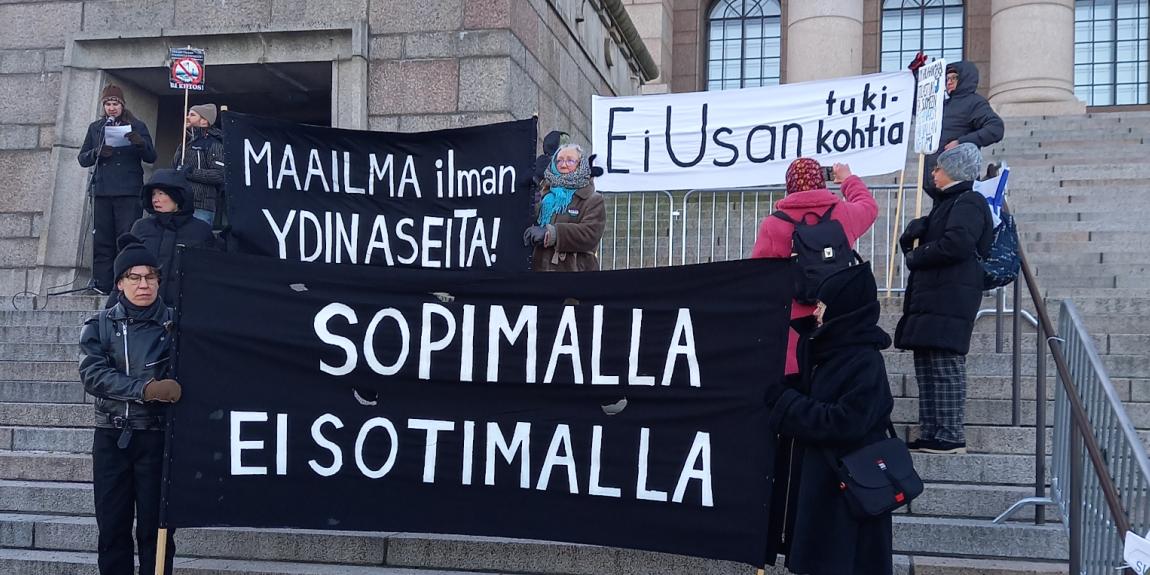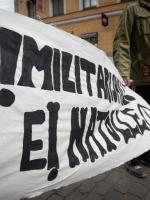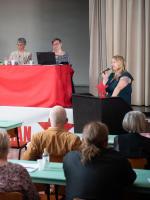US bases will bring problems, not security
The Defence Cooperation Agreement (DCA), the military treaty between Finland and the US, was published on 14 December - only after it had been agreed to the letter and approved by the government. There was no public discussion of its content and Finland's position on the US proposals.
Finland will make 15 military zones available to the US. They will stretch from Ivalo and Sodankylä in Lapland to Upinniemi and Raasepori on the south coast. Some areas within these zones will be for US use only, others for joint use. The US will also be able to operate in other areas and its troops will be free to come and move around in Finland.
The agreement sets no limits or restrictions on the number and type of troops and weapons the US can deploy in Finland. It does not even contain any restrictions on nuclear weapons.
Finnish sovereignty curtailed
US forces in Finland are subject to US decisions and legislation. US weapons and weapon systems stored here will also be under the exclusive control of the US. The US also has the power to control the areas under its control and their surroundings. The special status of the Åland Islands is mentioned in the agreement, but nothing is said about the status of the Sámi people.
At the beginning of the agreement it is stated that the US undertakes to "respect" Finnish sovereignty, legislation and international agreements. The US has made similar promises about military bases elsewhere in the world but has repeatedly broken them. Experiences from other countries also show the problems caused by the behaviour of US soldiers. The US did not even agree to include a provision banning the death penalty in the treaty. There has been an exchange of letters between Finland and the US on this issue, which the Chancellor of Justice did not consider to be clearly binding in his opinion on the NATO Status of Forces Agreement (Sofa).
US militarisation of the Nordic countries
The most dramatic aspect concerning Finland's sovereignty is that troops and weapons systems will be brought here whose use will be decided by the US and, if it so wishes, exclusively by the US. In this respect, the agreement is even stricter than the NATO agreement, which in principle requires unanimous decisions by NATO members.
At the same time, the DCA takes the change in Finland's security policy from a policy of peace and military non-alignment to one based on armament, nuclear deterrence and the USA even further.
The stationing of US troops, weapons systems and bases in Finland, close to strategically important Russian centres, does not increase Finland's security, but increases tensions in the region. This is particularly the case because Finland and the US do not want to impose any restrictions on the number of troops, weapons or even nuclear weapons. It is, therefore, above all an attempt by the US to involve Finland and the other Nordic countries in its superpower strategy and to militarise the Nordic area.
Contrary to what is often claimed, NATO membership does not mean that Finland has to sign a DCA with the US. NATO has a Sofa agreement, which defines the role and activities of the armed forces of member states on the territory of another member state.
Say "no" to the DCA
The best way to avoid conflict and becoming a pawn of the great powers is not to accept US bases on Finnish territory. Instead of confrontation and an arms race, we need a policy of peace in the Nordic area.
President Sauli Niinistö has said that the DCA is even more important than the NATO accession agreement. It would therefore have been at least reasonable to discuss its content before the government decided to authorise the signing of the agreement. The question now is whether there are MPs and presidential candidates who will oppose the DCA, and how Finns in Finland will judge it.
Appendix: Areas and facilities pledged to the US
Ivalo, Border Guard Barracks (facilities and areas reserved for national defence force operations)
Kuopio-Rissala, Karelia Air Base
Niinisalo garrison area and Pohjankangas-Hämeenkangas training areas
Parkano military storage area
Raasepori garrison area and Syndalen training area
Rovajärvi training area, including the Misi military storage area
Rovaniemi, Lapland Air Base and Jääkäriprikaati garrison area
Skinnarvik military storage area
Tammela storage area
Tampere-Pirkkala, Satakunta Air Base
Tervola military storage area
Jyväskylä-Tikkakoski, Air War College Air Base
Upinniemi Naval Base and garrison area in Kirkkonummi, including Russarö
Veitsiluoto military storage area
Vekaranjärvi garrison area and Pahkajärvi training area
Yrjö Hakanen, chair of the Helsinki district committee of the Communist party of Finland. www.yrjohakanen.fi 14.12.2023
Translation into English by Mark Waller




